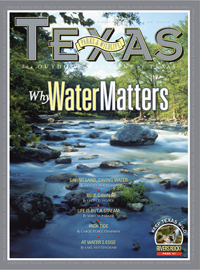
Flora Fact : Spiked Sausages
Cattails have many uses. You can even eat them!
By Sheryl Smith-Rodgers
Whooping cranes. World War II. Native Americans. What common denominator could three such divergent groups possibly share? Check this out: the humble but versatile cattail, a familiar forb associated with marshes, ponds and other soggy habitats.
Broadleaf cattail (Typha latifolia) — one of two species native to Texas — grows in dense stands along the edges of fresh and brackish water. Its aggressive, fast-spreading roots (rhizomes) send up narrow, sword-like leaves that reach 3 to 10 feet tall. From spring into early summer, flower heads appear, those spiked sausages (or “cattails”) that later turn into fluff. Tiny male flowers bloom along the spike at the top, then fall off. After pollination, the female flowers on the cattail turn from green into brown, releasing downy masses of seeds (some 200,000 to 300,000 each) in the fall.
Both humans and wildlife put cattails to use in countless ways. Native Americans and modern folks (remember wild-food enthusiast Euell Gibbons?) have cooked and eaten the male flowers like corn on the cob. Tender shoots collected in the spring are edible, and cattail pollen is used as a protein-rich baking additive. Native Americans also wove cattail leaves into mats, used seed fluff for baby beds and diapers and made an adhesive from the stems.

As for wildlife, whooping cranes nest among bulrush and cattails and use both as nesting material. (The endangered birds winter in Texas but don’t nest here.) Marsh wrens and red-winged blackbirds also inhabit and nest among cattails. Likewise, muskrats favor cattail colonies for food and habitat.
The WWII connection? When Japan occupied the Dutch East Indies, the U.S. Navy lost access to kapok, a plant fiber used to stuff life vests. For a brief time, the Navy substituted cattail and milkweed fluff. A rare cattail baler from the era is exhibited at a small county museum in Warren, Minn.

